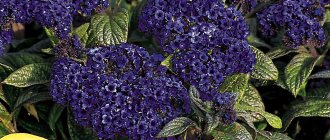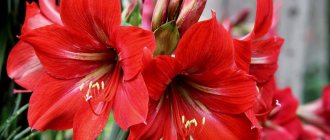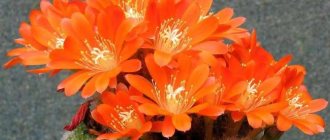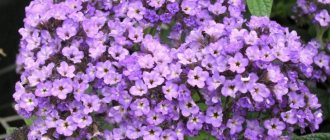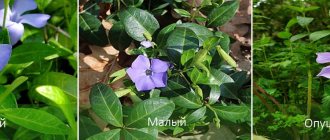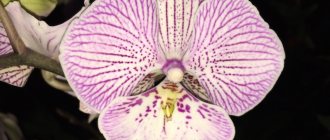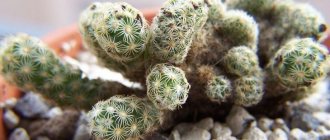Heliotrope flower: description of popular plant species and options for use in garden design
Semi-shrubs and herbaceous perennial plants do not require special care. The decorative crop has obovate, alternately arranged foliage of dark green color. Leaves with pubescence, wavy or wrinkled type, are located on fairly short petioles.
The flowers are small, fragrant, purple or dark blue in color, collected in dense corymbose inflorescences. In indoor floriculture, heliotropes can grow for several years, but in garden culture they are grown as a flowering, highly decorative annual. After flowering, fruits full of seeds are formed. Hybrid heliotrope is especially popular.
G. thyroid or thyroid
The tallest decorative species. The height of an adult plant reaches 120 cm. The above-ground part is represented by well-shaped stems and long, lanceolate, boat-shaped leaves. The outer part of the leaf blade has a slightly darker color. The flowering is beautiful and long-lasting, with blue or blue flowers collected in inflorescences up to 8-10 cm long. The culture is widely used as a background for creating multi-tiered flower beds, and is also suitable for group and single plantings.
G. peruvian
Peruvian or Tree-like is one of the most common species in culture , and is a spreading bush with a height of the above-ground part of up to 40-60 cm. Fragrant and beautiful flowers of dark purple or rich bright blue color are collected in relatively large inflorescences that bloom before frost. The most popular hybrid forms include the “Marin” series. It is often used in group flower arrangements and single plantings when decorating the landscape of a personal garden.
G. Kurasavsky
The species is a spreading, rather tall shrub. The diameter of the above-ground part is often 110-120 cm, with an average height of no more than 60-100 cm. The flowers are pale bluish-white, collected in inflorescences with a strong and long peduncle. The plant combines well with conifers and decorative deciduous perennials.
G. stem-encompassing
The shortest species, not particularly popular among amateur gardeners. The ornamental plant is distinguished by long lanceolate leaves with characteristic wavy edges and attractive purple flowers. In landscaping it is used as a carpet plant and planted to decorate borders and flower beds. Serves as an excellent complement to salvia, tuberous begonia and garden petunia.
G. European
The perennial species “European” is characterized by a bush-like form with a height of the above-ground part of up to 35-40 cm. The foliage is greenish-yellow in color. The flowers are distinguished by original curls and a white corolla. They are located in the axils of the upper leaves. During the active flowering phase, the entire plant is covered with lush and dense inflorescences.
Pests and diseases
The plant is not very susceptible to diseases and pests. Lesions can appear due to lack of care and pruning errors. Serious consequences can be caused by excessive watering of the plant, which leads to root rot and infection with parasitic fungi.
The vanilla aroma of heliotrope is an excellent bait for flying insects, especially flies. Since they lay eggs on the underside of the leaf and later hatch into larvae, the pests should be dealt with immediately. It is necessary to monitor the presence of pests, of which the most common problem is aphids; sometimes the flower is affected by whiteflies.
The best plant varieties
Despite the very large number of natural species, varieties belonging to the Peruvian or tree species (H. peruvianum, arborescens) have become widespread in culture. Such varieties are characterized by relative unpretentiousness, very abundant and fragrant flowering.
In flower beds, the crop can be very successfully combined with coreopsis and different types of begonias, rudbeckias, as well as mixtures of coleus. Among other things, a very effective flower combination can be obtained by planting different varieties of heliotrope in combination with petunia or cineraria.
Caring for an adult plant
Judging by the reviews, Marin heliotrope is a fairly unpretentious crop only in the adult phase. If you manage to keep the plant in good health for a year after planting, then further care for it will not be difficult. It will be enough to moisten the soil in a timely manner, take care of additional shading on hot summer days, cover the flower for the winter and fertilize the soil with organic and mineral fertilizers. We will examine all these nuances in more detail in the following sections.
How to sow heliotrope seeds (video)
Heliotrope “Sea Breeze”
The “Sea Breeze” variety is a compact ornamental plant with a height of the above-ground part of up to 40-45 cm, with bright fragrant inflorescences. The flowers are small in size, dark blue or dark purple in color, collected in corymbose inflorescences. Flowering is abundant and long lasting. The foliage is dark green with a purple tint. The leaves have a very characteristic obovate shape for the species.
Heliotrope "Dwarf Marine"
“Sea Dwarf” variety It is characterized by the formation of attractive and very fragrant inflorescences consisting of bright blue flowers.
"Odysseus"
The variety "Odyssey" is a perennial plant grown as an annual. The variety is represented by a densely branching herbaceous bush with an above-ground part up to 25-30 cm high. Flowering is very abundant and long-lasting. The bush produces small and extremely fragrant flowers, collected in characteristic corymbose inflorescences. The highly decorative crop is used for landscaping balconies and loggias, is used in potted plants and in the design of carpet flower beds in personal plots.
"Princess Marina"
The variety “Princess Marina” is a compact and relatively low plant, distinguished by flowers with an intense violet-blue color. The inflorescences are quite lush and highly decorative, characterized by a weak and unobtrusive aroma.
"White Lady"
The varietal feature of the heliotrope “White Lady” is a compact and low-growing, abundantly flowering crop. It is distinguished by buds of a pleasant soft pink color. At the stage of full dissolution, the flowers acquire a snow-white color.
"Regal Dwarf"
Compact bush-like form, characterized by the formation of large and very fragrant flowers. Its short stature and decorative appeal have proven this variety excellent in indoor floriculture and in the design of garden flower beds.
Compatibility with other plants
In order for Marin heliotrope to feel as comfortable as possible in the open ground, it is necessary to follow the basic rules of the neighborhood. It is highly not recommended to plant the flower in areas where there are large trees, as they create unnecessary shading. But climbing roses or marigolds will be excellent neighbors for heliotrope, since they not only do not interfere with its normal growth, but also harmoniously combine with its appearance and aroma. You can also add garden geranium or petunia to the flowerbed to dilute the dazzling purple tone of heliotropes with another color. Wormwood and lavender can also help with this. However, do not forget that if one plant is damaged by pests, the insects will spread to neighboring plants.
Growing heliotrope from seeds
As a rule, approximately three to four months pass from germination to the phase of active mass flowering , so sowing work is recommended to be carried out from the last ten days of February to mid-March. It is best to prepare a nutrient mixture for growing based on non-acidic peat and medium-grained sand in a ratio of 4:1. You can also use regular store-bought flower soil.
Planting containers with drainage holes must be filled with moist, disinfected soil mixture. Sowing is done superficially or with a slight sprinkling of a nutrient mixture, which will prevent the risk of drying out. Crops must be covered with plastic film and installed in a room with a temperature regime of 18-20°C. After the mass emergence of seedlings, flower seedlings need to be provided with a sufficient amount of light and air temperature within 20-22°C. Diving into separate seedling pots is done after three or four leaves appear.
Growing conditions
Lighting
The flower loves good lighting, but in direct sunlight the petals quickly fade. Heliotrope is best planted in lacy shade.
Soil requirements
Fertile, moisture-absorbing, neutral or slightly acidic. To grow heliotrope indoors, buy ready-made soil for home flowers or a mixture for tomato seedlings.
To place it in the garden, prepare a substrate by mixing peat, humus, sand and turf soil.
Planting technology
Before transplanting seedlings to a permanent place, it is necessary to provide the plants with hardening measures. Planting flower seedlings in open ground flower beds is carried out after the threat of damage to the ornamental crop by late return frosts has passed.
In the first weeks after planting, it is advisable to provide protection to young and immature plants using a frame-film cover. The planting scheme may vary depending on the species and varietal characteristics . Before planting, it is necessary to add high-quality humus to the planting hole, after which the root system of the plant is carefully placed and buried in soil. After compacting the soil, it is very important to water sufficiently abundantly with settled water.
Types and varieties
Heliotrope (Heliotropium L.) is a genus of perennial plants of the Borage family. The genus includes approximately 250 species found in most warm to temperate climates.
Common types:
- Heliotropium europaeum L – European heliotrope, typical species;
- Heliotropium peruvianum - Peruvian or Peruvian heliotrope;
- Heliotropium corymbosum – corymbose heliotrope;
- Heliotropium lasiocarpum is a pubescent heliotrope, found in the south of Russia and Ukraine as a weed.
There are many interesting varieties of heliotrope on the market. The main distinguishing feature of the varieties is the color of the flowers.
Interesting varieties
| Variety name | Photo |
| With purple and pink flowers | |
| "Lord Robert" | |
| "Chatsworth" - bluish flowers | |
| 'Marina' Marine with compact form, purple-blue flowers | |
| “Sea Breeze” – purple-blue flowers | |
| "Odysseus" - purple flowers | |
| With white flowers | |
| "White Lady" - white flowers with a delicate pink-violet tint, smells of vanilla | |
In our climatic conditions, mainly Peruvian heliotrope, also known as garden or tree heliotrope, is grown. As the name suggests, this perennial originates from Peru. It also grows wild in neighboring Ecuador. In terms of distribution, Peruvian heliotrope belongs to the Andean natural range and is one of the best known local species. It is also called aromatic because it smells like vanilla. The oil obtained from the flowers of this plant is used in the perfume industry.
Peruvian heliotrope is a perennial, depending on the variety, 30-60 centimeters high. Its varieties differ in flower color, shape and height. In its homeland, it is a shrub with oval, lanceolate leaves covered with coarse hairs. Flowers with a thin violet, purple and rarely white crown. Peruvian heliotrope blooms from July to September, 3 months after sowing.
The rest of the article describes the care and cultivation of Peruvian heliotrope.
Heliotrope: home care
When growing indoors, it is very important to follow a few simple recommendations:
- the crop needs to be provided with sufficient lighting while protecting the above-ground part from direct sunlight. It is considered optimal to place it on windowsills facing east and west;
- sufficient thermophilicity presupposes compliance with the temperature regime. In spring and summer, the temperature when visiting should be approximately 20-24°C. With the onset of autumn and winter, the temperature regime is no more than 16-18°C;
- Air humidity indicators require special attention. It is necessary to use regular spraying of the above-ground part with warm and settled water;
- With the beginning of active growing season and before flowering, the ornamental crop needs abundant and regular moistening of the earthen clod. Do not overdry or over-moisten the nutrient substrate in a flower pot. Water for irrigation must be soft and at room temperature;
- fertilizing is carried out from March until the end of the period of mass flowering. Complex mineral fertilizers are applied twice a month.
Indoor heliotrope needs to be replanted every year, around mid-March. The decorative perennial needs to be removed from the flower container, the damaged roots should be cut off and planted in a new flower pot that has a larger volume. A drainage layer must be poured onto the bottom of the planting container. After replanting, the above-ground part must be pinched.
A nutritious soil substrate based on four parts of turf substrate, a couple of parts of deciduous soil, a couple of parts of non-acidic peat and one part of coarse sand with the addition of a small amount of crushed charcoal and granular complex fertilizer is optimally suited for cultivation. Before replanting, the nutrient mixture must be disinfected in the oven.
Features of reproduction
Previously, the crop was propagated mainly using cuttings. As selection developed, many new varieties arose that were propagated by seeds.
In the case of propagation by cuttings, the mother flower is carefully dug out of the soil along with a lump of earth, placed in a suitable container and left to overwinter in a warm room. Marin heliotrope cuttings are prepared in mid-February. Each shoot should have three to four internodes. The abundance of foliage weakens the cuttings.
Features of outdoor care
To grow a profusely flowering and highly decorative plant, it is recommended to allocate areas well lit by the sun or with slight shading. The soil of the flower garden must be prepared in advance. The main feature of standard care for heliotrope of any type and variety is timely and moderate irrigation measures. To moisten the soil, it is advisable to use rainwater heated in the sun.
Immediately after irrigation activities, it is advisable to loosen the soil around ornamental plants a little. Such an event can be combined with the removal of weeds. Mulching the soil in flower beds gives very good results. For this purpose, you can use almost any organic matter, including sawdust and leaves and compost. To get the most abundant and long-lasting flowering, it is recommended to periodically pinch the stems.
Choosing a landing site
Heliotrope Marin is very demanding in terms of lighting, so it is worth choosing a place that is illuminated by the sun most of the day. The best option for growing is a terrace or balcony with large windows. Also, all heliotropes can be grown outside in flower beds. They are often used to form borders, which not only look very impressive, but also smell pleasant. However, when planting in open ground, it is recommended to protect the area from rain and strong winds. It is best to plant the plant under polycarbonate canopies, avoiding places near the corners of buildings, as they often experience strong drafts.
Heliotrope: pinching (video)
The plant can be damaged by whiteflies, aphids or dangerous spider mites, to destroy which the aerial parts should be treated with a special modern preparation, Actellik. As a result of excessive irrigation measures and excessive accumulation of moisture in the soil near the root system, gray mold damage to ornamental crops can occur. At the first signs of fungal infection, fungicide treatment is performed.
All types of heliotropes are very impressive and are highly decorative. It is possible to get a new bush of this perennial crop yourself not only by sowing seed material, but also by cuttings. However, it must be remembered that only a limited number of varieties and hybrid forms are suitable for cultivation at home and in garden floriculture.
Collecting seeds
Growing heliotrope is not difficult. But collecting plant seeds is not so easy. Getting your own seeds does not always give good results. And the reason for this is our climate. In our latitudes, seeds do not have time to ripen, so experienced gardeners do not recommend wasting time and effort on a futile process. It is easier to purchase certified seed material in specialized stores. High-quality seeds will allow you to grow good plants. If you want to try your hand as a breeder, you need to wait for the period when the inflorescence not only withers, but also turns black. After this, you can cut it and open the boxes in search of seeds, which must be thoroughly dried. Before sowing, they must be stored in cardboard packaging.
When is the best time to plant heliotrope seedlings in 2022
The period of development of heliotrope seedlings is quite long (after the first shoots it takes about 80-110 days before flowering). Therefore, it is important to observe the sowing time in order to have time to enjoy the flowering in full.
The optimal time for sowing heliotrope for seedlings: late February, early March. If you have the opportunity to supplement the seedlings with phytolamps, then you can plant the seeds in January or early February.
By the way, you can choose the time for planting seeds using the Lunar calendar 2022:
- Favorable days: in January: 1, 10, 11, 15, 16, 19, 20;
- in February: 7, 8, 12, 13, 14, 15;
- in March: 10, 11, 15, 20, 21, 24, 25.
- Unfavorable days: in January: 2, 18th;
- in February: 1, 16;
- in March: 2, 16, 17, 18, 31.
Problems
Let's look at common problems in the table:
| Problem | Corrective measures |
| Gray rot | Preventive measures, at the onset of the disease, antiviral drugs, in other cases, removal of diseased bushes, fertilizing with Bordeaux mixture. |
| Rust on leaves | Spraying with Bordeaux mixture or a solution of sulfur and lime. |
| Whiteflies | Insecticidal solutions are used |
| Aphid | It is best to carry out prevention by destroying the cause: carriers of aphids - ants. |
| Spider mites | The plant requires sprinkling, and plenty of it, which will knock off all the pests. |
Disease or insect attack is easier to prevent than to treat. Do not forget to continuously examine the stems, buds and leaf blades, identifying signs of metabolic disorders occurring inside the clematis: yellowing, wilting, spots, tears and cracking.
Picking heliotrope seedlings
Picking is an inevitable procedure when sowing seeds in a common container (box, bowl). This process means transplanting seedlings into individual containers. Thus, young plants have a feeding area and space for the development of the root system.
The timing of picking should be determined by the appearance of the above-ground parts of the plants: when the first 2 true leaves appear . It is not recommended to overexpose plants; in a common container, their roots may become intertwined, which will make it difficult to pick them out without damaging the root system.
cups or pots with a volume of 200 ml or a diameter and height of 9-11 cm are most suitable . You can replant in exactly the same soil that you used for sowing.
Picking heliotrope seedlings is carried out according to the following scheme:
- On the day of the procedure, water the plants with plain water several hours in advance.
- Prepare the soil, cups, some kind of stick or plastic spoon/fork.
- Fill all the cups with soil and make a large hole in each of them.
- Very carefully pick up the seedlings (one at a time) with a stick or other convenient tool. Be careful not to damage the roots.
- Without shaking the soil off the roots, transplant the seedling into the hole. The roots should be positioned there evenly, they should not bend.
- Fill the holes with soil and lightly compact the soil with your fingers. Water generously with clean water. If the soil settles after a while, add more soil to the previous level.
After picking, it is necessary to care for the seedlings with some changes:
- Picking is always stressful for plants, so in the first 3-4 days after the procedure you need to put them in a place with diffused light. Direct sunlight will cause additional and unnecessary stress.
- If you damaged the roots during transplantation, it is highly recommended that after watering with plain water, pour a solution of a growth stimulator, for example, Kornevin, Epin, Zircon, under the seedlings.
- 2 weeks after picking, it is useful to feed heliotrope seedlings with any complex fertilizer for seedlings. You need to fertilize according to the instructions. Be sure to water the seedlings with plain water a couple of hours before feeding.
The magical power of the mineral
Its magical properties have been known since ancient times. People began to use its powers as soon as they discovered the mineral. It was used by both magicians and alchemists. At that time, it was believed that if during any spell or ritual the mineral was used together with a flower, also called heliotrope, a better effect could be achieved.
Many magicians wore this stone in order to increase their energy potential with its help. After all, it was believed that it increases the power of the sorcerer. As for the alchemists, they studied the crystal in order to unravel all the secrets of the Universe.
The Church was also interested in heliotrope. It is still used in the interior of temples. In addition, candlesticks and bowls for rituals are made from it. Other church accessories are also made from it.
Despite the fact that this stone is surrounded by magic, anyone can use it, even if it has nothing to do with mysticism and religion. It can help an ordinary person achieve their goals. It also helps you become more confident. Thanks to it, people become more attentive and focused on one thing, which leads to a successful result.
This crystal can also push a person to engage in self-development. Under its influence, everyone strives for knowledge and development. This is best demonstrated by people who are interested in:
- Philosophy;
- Linguistics;
- Medicine;
- Psychology;
- Science.
Despite all the advantages of the talisman, it also has its disadvantages. Due to the influence of the stone, a person may develop a fanatical attitude towards magic, study, science, work and faith. There are stories of people going crazy because of it. To avoid such consequences, you should wear the talisman not on an ongoing basis.
For example, it is recommended to wear it exclusively for a very important interview or meeting. In this case, you don’t have to worry about clouding your mind
Care after flowering
After flowering, the seeds ripen, they are collected and sent for storage, carefully labeling the bags.
Note!
The collected planting material most likely will not produce flowers that have the characteristics that were purchased from the correct src=”https://zelenj.ru/wp-content/uploads/2019/05/heliotrope-1-600×400.jpg” class=”aligncenter” width=”600″ height=”400″[/img]
The remaining green mass is cut off and compost is obtained from it. Due to the high content of essential oils, you can leave them on the beds to repel some pests and dig them up in the spring.
Some plants can be transplanted from the flowerbed into flower containers and left to overwinter on the windowsill, and a garden can be planted next spring.
